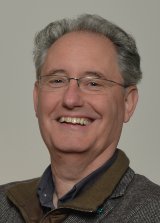Projects per year
Personal profile
Research interests
The research of the Biomedical Photonics group of the Biomedical Engineering and Physics department of the AMC (headed by Ton van Leeuwen) focuses on the physics of the interaction of light with tissue, and to use that knowledge for the development, introduction and clinical evaluation of (newly developed) optical imaging and analysis techniques for gathering quantitative functional and molecular information of tissue or tissue sample ("optical biopsy"). The research bridges the gap between lab and clinic (“bench to bedside”). Techniques developed and used are optical coherence tomography, (single fiber) reflectance spectroscopy, hyperspectral imaging and Raman spectroscopy.
The research is structured along the following research lines:
- Tissue spectroscopy: By studying the interaction of light with tissue for dedicated set-ups and fibers, models and algorihtms are developed in order to determine the concentration of blood and blood derivatives, met-, deoxy- and oxyhemoglobin, as well as the flow in various organs. This information can be used to monitor the function of organs as well as to improve the detection of tumors, child abuse and other pathologies.
- Functional imaging: based on the fundamental research of Dirk Faber, the use of the intrinsic contrast of OCT is explored with Martijn de Bruin for the in vivo staging and grading of tumors, together with clinical departments (e.g. Urology, Pulmonology, MDL). Novel OCT signal analysis is explored to determine blood velocity profiles, perfusion and diffusion and relate this information to pathology, together with clinical departments. The integration and combination of different imaging technologies (e.g. OCT and CT, (Raman) spectroscopy and OCT) is explored and clinically evaluated.
- Extracellular vesicles (EVs) detection: based on the research of Edwin van der Pol and in cooperation with experimental clinical chemistry (Rienk Nieuwland), new optical techniques for the detection of EVs in blood plasm are developed. In this novel research line, we aim to quantify the size distribution, the concentration (via sophisticated microscopic detection techniques) and cellular origin (via spectroscopic techniques) of these small (30-1000 nm) particles in order to design "liquid biopsy" tools. We intiated the STW perspectief program CANCER-ID.
- Photonic device development: We develop novel photonic devices, based on minimally invasive designs and integrated optics, which are suitable for small and dedicated monitoring and imaging devices in the clinic ("cleanroom to clinic").
Our research is embedded in the Center of Research Excellence on Innovative Medical Devices “Institute Quantivision”, a collaboration between UvA-FNWI, AMC, NKI, VUmc and VU, in which Ton van Leeuwen is the technical scientific leader. Our group is also part of the “LaserLaB” of the VU and the Co van Ledden Hulsebosch Center for Forensic Sciences of the UvA-FNWI, NFI and AMC.
specialisation
specialisation
Biomedical Optics
Expertise related to UN Sustainable Development Goals
In 2015, UN member states agreed to 17 global Sustainable Development Goals (SDGs) to end poverty, protect the planet and ensure prosperity for all. This person’s work contributes towards the following SDG(s):
Collaborations and top research areas from the last five years
-
van Leeuwen A.G.J.M.: Biomedical photonics for functional and molecular imaging
Achetib, N., Almasian, M., Bus, M., Gool, E., Hoveling, R., Jansen, I., Jansen, S., Jelvehgaran, P., Fagalde, K., Lucas, M., Muller, B., Peinado Cortes, L., Post, A., de Rond, L., Swaan, A., Wilk, L., Zhang, X., van Leeuwen, T., Aalders, M., Faber, D., de Bruin, M., Coumans, F., van Dam, A., van der Pol, E. & Riordan, A.
1/02/2007 → …
Project: Research
-
-
Light interactions with gold nanorods and cells: implications for photothermal nanotherapeutics
Ungureanu, C., Kroes, R., Petersen, W., Groothuis, T. A. M., Ungureanu, F., Janssen, H., van Leeuwen, F. W. B., Kooyman, R. P. H., Manohar, S. & van Leeuwen, T. G., 2011, In: Nano letters. 11, 5, p. 1887-1894Research output: Contribution to journal › Article › Academic › peer-review
132 Citations (Scopus) -
Single vs. swarm detection of microparticles and exosomes by flow cytometry
van der Pol, E., van Gemert, M. J. C., Sturk, A., Nieuwland, R. & van Leeuwen, T. G., 2012, In: Journal of thrombosis and haemostasis. 10, 5, p. 919-930Research output: Contribution to journal › Article › Academic › peer-review
312 Citations (Scopus) -
Refractive Index Determination of Nanoparticles in Suspension Using Nanoparticle Tracking Analysis
van der Pol, E., Coumans, F. A. W., Sturk, A., Nieuwland, R. & van Leeuwen, T. G., 2014, In: Nano letters. 14, 11, p. 6195-6201Research output: Contribution to journal › Article › Academic › peer-review
156 Citations (Scopus) -
Oxidation monitoring by fluorescence spectroscopy reveals the age of fingermarks
van Dam, A., Schwarz, J. C. V., de Vos, J., Siebes, M., Sijen, T., van Leeuwen, T. G., Aalders, M. C. G. & Lambrechts, S. A. G., 2014, In: Angewandte Chemie (International ed. in English). 53, 24, p. 6272-6275Research output: Contribution to journal › Article › Academic › peer-review
54 Citations (Scopus) -
Fluence is unequal to incident energy density or radiant exposure
van Gemert, M. J. C. & van Leeuwen, T. G., 1 Feb 2024, In: Lasers in surgery and medicine. 56, 2, p. 125Research output: Contribution to journal › Comment/Letter to the editor › Academic
1 Citation (Scopus)
